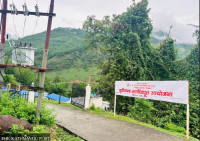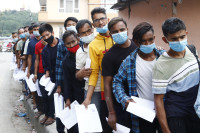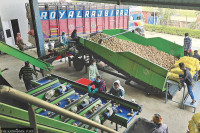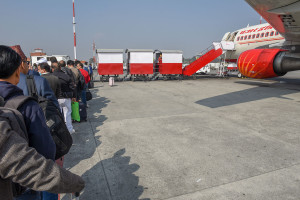Money
‘Farmer field school’ to boost cardamom haul
The District Agriculture Development Office has launched a “farmer field school” programme to educated large cardamom producers to adopt practices to reduce pest infection that are environmentally sound, beside educating them on sustainable agricultural practices.
Biplav Bhattarai
The District Agriculture Development Office has launched a “farmer field school” programme to educated large cardamom producers to adopt practices to reduce pest infection that are environmentally sound, beside educating them on sustainable agricultural practices.
Under the programme, farm technicians will go to farmer’s field regularly and launch education sessions on the new technologies and methods into their farming.
The technicians will be providing 10 months education in the selected areas. The approach is expected to help farmers to incorporate the latest technology tools into their daily operations. The technicians will educate them with the proper management of fertilizers and irrigation system and the method to reduce pest infections, directly in their field.
The results of enhancing their operations with these tools increase efficiency, said Ravi Kiran Adhikari, an agricultural extension officer in Deumai Municipality. “As there are no remedies for the pest infection in large cardamom plants, the farmer filed school approach will help them to adopt practices to reduce pest infections.”
The office will be operating the farmer filed school programme in 18 different areas in Ilam. The high-value cash crop is produced mainly in the eastern hills in Nepal. Outside Nepal, the spice is grown only in Sikkim and Darjeeling in India and Bhutan. Large cardamom was introduced into Ilam from Sikkim in 1865.
In the past, a large number of farmers had destroyed their old cardamom crops due to pest infestation. The new plants have started bearing fruits and production has started increasing gradually. The area where large cardamom is grown had shrunk to 1,509 hectares in 2014-15 as farmers started planting the crop on new fields.
In 2015-16, the area under large cardamom cultivation rose slightly to 1,550 hectares and output amounted to 558 tonnes, up 7.18 percent.
However, still there are some areas where farmers are producing large cardamom in a traditional way. They are still suffering from the viral diseases of large cardamom called as chirke (mosaic streak) and furke (bushy dwarf). “The large cardamom farming method is different to what some farmers have been adopting,” said Ganesh Rai, a technician at the District Agriculture Development Office.
Many farmers do not have the most up-to-date information on how to grow the crop efficiently and economically. “The farmer field school will provide knowledge of new techniques to improvise their farm.”
Agro expert Shiva Lal Karki said that the farmer education is basically methods and technologies that do not have an overly negative effect on soil, water, and air quality. In the last fiscal year, Ilam produced 573 tonnes of large cardamom.




 18.12°C Kathmandu
18.12°C Kathmandu














